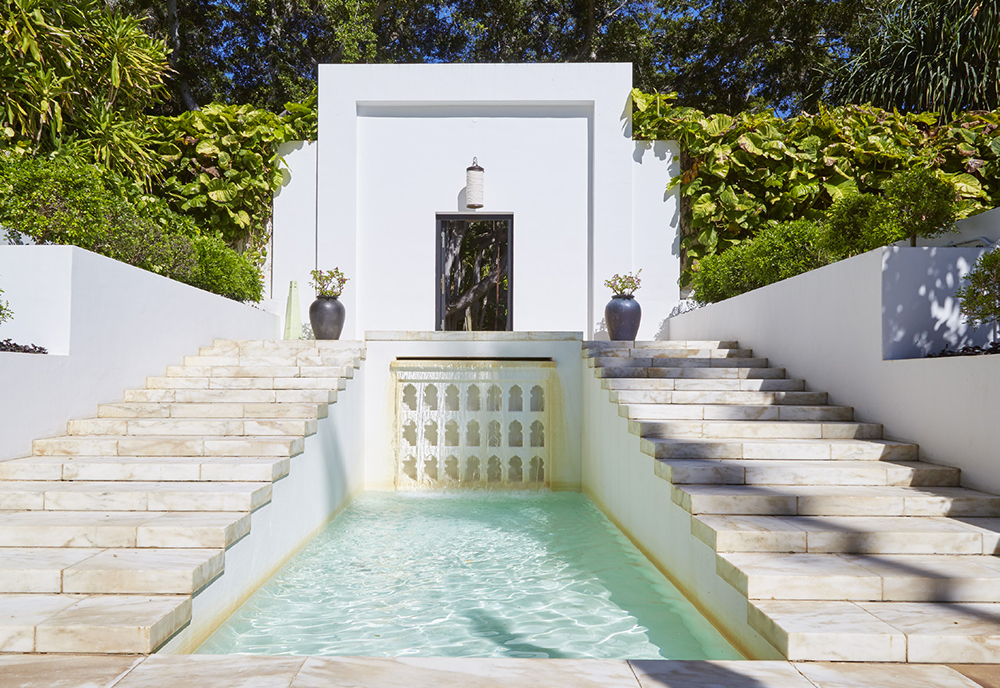Doris Duke’s glorious Honolulu home, Shangri La, is now a paradise of cultural preservation and understanding
Written by Jenn Thornton | Photos Courtesy of The Doris Duke Foundation for Islamic Art
Much has been made of Doris Duke—her dalliances and eccentricities, her vast fortune and reclusive nature. In 1925, the 12-year-old, only child of an American Tobacco Co. tycoon inherited millions, making her the “richest little girl in the world.”
 One with a penchant for hopping continents, first with her parents, then with her husband, James Cromwell, with whom she honeymooned across the globe.
One with a penchant for hopping continents, first with her parents, then with her husband, James Cromwell, with whom she honeymooned across the globe.
Beguiled by Hawaii, the couple extended their stay there and went on to purchase a dazzling oceanfront parcel near Diamond Head, outside Honolulu, for Duke’s Islamic-inspired eden—Shangri La.
On the surface, Shangri La is the grand, expressive statement one might expect a tremendously prosperous person to own, particularly in the 1930s, when it also reflected a fashionable interest of the era. “At the time of her travels through the Islamic world, affluent families in New York City were enamored with the orientalist fantasies,” explains Konrad Ng, executive director of the home’s current role as Shangri La Center, A Museum of Islamic Art, Culture & Design.
 But, he adds, “Doris Duke’s curiosity was the start of what became a more meaningful engagement with Islamic art and the recognition of its great value.”
But, he adds, “Doris Duke’s curiosity was the start of what became a more meaningful engagement with Islamic art and the recognition of its great value.”
Shangri La articulates quite significantly her “deep embrace of the world-at-large” and “her admiration of the history and heritage of peoples and cultures that may not have been her own.”
Completed in 1939, Shangri La is comprised of 5 acres, on which the main house stretches a magnificent 14,000 square feet. Architecturally, the property’s most signifying feature is the Central Courtyard, its open-air ceiling and fountain indicative of a Middle Eastern home. Of the mansion’s 12 rooms, a number have undergone dramatic changes. The Damascus Room was transformed into its current state in the 1950s, when Duke purchased an authentic Syrian interior for the space; the Dining Room, formerly ocean-themed, sported a wall of aquariums and a traditional dining table and chairs; and the Syrian Room was once a billiards room with an office on the upper floor.
 Most spaces, however, have changed only with textiles, furniture arrangement, and new acquisitions over the course of Duke’s lifetime. The Mughal Suite, a jewel-box bedroom and bath that borrowed inspiration from the Taj Mahal, remains striking with marble inlay panels and carved marble screens. Intended to mimic royal gardens on the Indian subcontinent, the Mughal Garden offers exterior flourish, complemented by the Playhouse, a poolside pavilion that replicates an ancient Iranian palace. Interior touches are rich and flavorful.
Most spaces, however, have changed only with textiles, furniture arrangement, and new acquisitions over the course of Duke’s lifetime. The Mughal Suite, a jewel-box bedroom and bath that borrowed inspiration from the Taj Mahal, remains striking with marble inlay panels and carved marble screens. Intended to mimic royal gardens on the Indian subcontinent, the Mughal Garden offers exterior flourish, complemented by the Playhouse, a poolside pavilion that replicates an ancient Iranian palace. Interior touches are rich and flavorful.
Highlights include ornate tilework (most from the Ilkhanid period); late Ottoman-Syrian interiors and furniture; a vibrant foyer ceiling made in Morocco; colored-glass windows; and a kaleidoscope of textiles and carpets for a lavish cultural tapestry.
In all, the Shangri La collection encompasses some 4,500 objects, the majority of which were created in the Islamic world. Of these holdings, most notable are two intact
Damascene interiors (the aforementioned Damascus Room and Syrian Room), which offer a chance to see traditional painted woodwork, or ‘ajami, up close outside of Syria; the ceramic luster Veramin mihrab (48.327), which dates from 1265 AD and features a rare signature and date; and a pair of shaped Indian Mughal carpets (81.49 and 81.50) from the 17th century.
History may call Doris Duke an heiress, but she is best considered a philanthropist, one who used her wealth for the cultural inheritance of all.
With a place like Shangri La, the “richest little girl in the world” became a true woman of the world.





